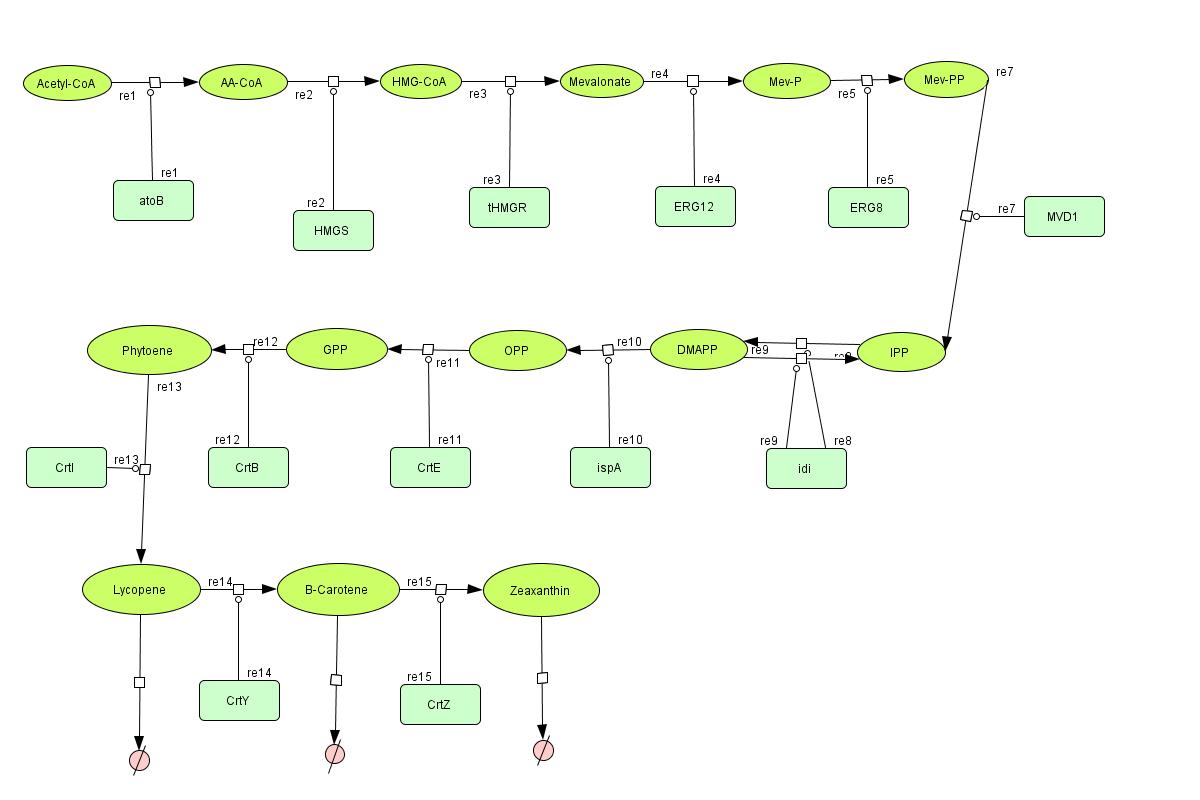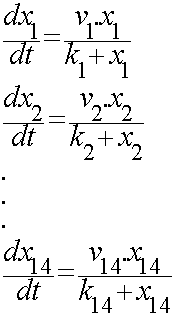Team:TUDelft/Color modeling
From 2008.igem.org
| Line 4: | Line 4: | ||
<div id="tudelft_content"> | <div id="tudelft_content"> | ||
| + | >> work in progress | ||
| + | |||
| + | ==Color Modeling== | ||
In the output we use [http://www.lbl.gov/Science-Articles/Archive/assets/images/2004/Mar-24/Engineering_terpenoids.pdf mevalonate] and [http://parts.mit.edu/igem07/index.php/Image:Zeaxanthin.jpg GPP] pathways together to produce red, orange and yellow colors. | In the output we use [http://www.lbl.gov/Science-Articles/Archive/assets/images/2004/Mar-24/Engineering_terpenoids.pdf mevalonate] and [http://parts.mit.edu/igem07/index.php/Image:Zeaxanthin.jpg GPP] pathways together to produce red, orange and yellow colors. | ||
The biosynthetic model is bulit in '''CellDesigner™'''. There are 14 subtrates and 13 enzymes in total. The first subtrate is Acetyl-CoA which is provided to the pathway in a constant level. The last three subtrates are the color products and are consuming so we have degradation links for them. Lycopene, B-carotene and Zeaxanthin give red, orange and yellow colors respectively. | The biosynthetic model is bulit in '''CellDesigner™'''. There are 14 subtrates and 13 enzymes in total. The first subtrate is Acetyl-CoA which is provided to the pathway in a constant level. The last three subtrates are the color products and are consuming so we have degradation links for them. Lycopene, B-carotene and Zeaxanthin give red, orange and yellow colors respectively. | ||
| + | [[Image:Mevalonate.jpg |550px|center]] | ||
| + | |||
| + | <center> <b> Color Pathway </b> </center> | ||
| + | |||
| + | |||
For the 14 reactions of enzyme-subtrate the Michaelis-Menten kinetics is applied and we have the mass action kinetics for the three degradations. | For the 14 reactions of enzyme-subtrate the Michaelis-Menten kinetics is applied and we have the mass action kinetics for the three degradations. | ||
According to the kinetic laws there are 14 differential equations for enzyme-subtrate reactions and three for degradations which could be constructed as: | According to the kinetic laws there are 14 differential equations for enzyme-subtrate reactions and three for degradations which could be constructed as: | ||
| Line 18: | Line 26: | ||
| - | |||
| - | |||
| - | |||
| - | |||
| - | |||
| - | |||
| - | |||
</div> | </div> | ||
{{Template:TUDelftiGEM2008_sidebar}} | {{Template:TUDelftiGEM2008_sidebar}} | ||
Revision as of 14:53, 21 August 2008
>> work in progress
Color Modeling
In the output we use [http://www.lbl.gov/Science-Articles/Archive/assets/images/2004/Mar-24/Engineering_terpenoids.pdf mevalonate] and [http://parts.mit.edu/igem07/index.php/Image:Zeaxanthin.jpg GPP] pathways together to produce red, orange and yellow colors. The biosynthetic model is bulit in CellDesigner™. There are 14 subtrates and 13 enzymes in total. The first subtrate is Acetyl-CoA which is provided to the pathway in a constant level. The last three subtrates are the color products and are consuming so we have degradation links for them. Lycopene, B-carotene and Zeaxanthin give red, orange and yellow colors respectively.
For the 14 reactions of enzyme-subtrate the Michaelis-Menten kinetics is applied and we have the mass action kinetics for the three degradations.
According to the kinetic laws there are 14 differential equations for enzyme-subtrate reactions and three for degradations which could be constructed as:
 "
"

